The Iris is a gorgeous type of perennial plant. Everything about it screams grace and elegance, from its tall thin stem to beautiful drooping petals with watercolors markings types of irises.
Despite its seemingly fragile nature, this plant is incredibly widespread across the Northern Hemisphere and not in areas you would expect it to grow easily.
From Northern Europe to East Asia and even across North America, Irises grow in abundance.
The surprising thing is that Irises prefer dry, arid environments or cold, rocky mountainous areas, two places you would normally place in complete contrast.
Though they can and do grow in meadows, grassy areas, and bog lands, it is the former two extreme environments where they are most at home.

An Iris is a great plant to have in your garden. While other plants give an overall sense of warmth and comfort in both color and blooms, the Iris gives a quiet tranquility you’d expect from an unexplored pond in a fen, something you can rarely find nowadays.
With that said, there are a few different types of Iris, and it might be hard to choose one for your garden or indoor display.
As such, we will take you through the different varieties of Iris and the characteristics they display.
The Different Types Of Iris
The issue with doing a list of the different types of Iris is that there are over 300 varieties of the plant, making it the most numerous in its own family’s genus.
Due to not being as highly sought after as other plants, this causes a bit of an issue, as there is less information to deduce the type of Iris you would most like to display.
Therefore, for this list we have decided to narrow down the Iris plants into a group of the most popular, thereby giving you the Iris plants with the most information on them.
If you should want to find out more about different varieties than the ones we display, you will have to find the information on your own.
1. Bearded Iris
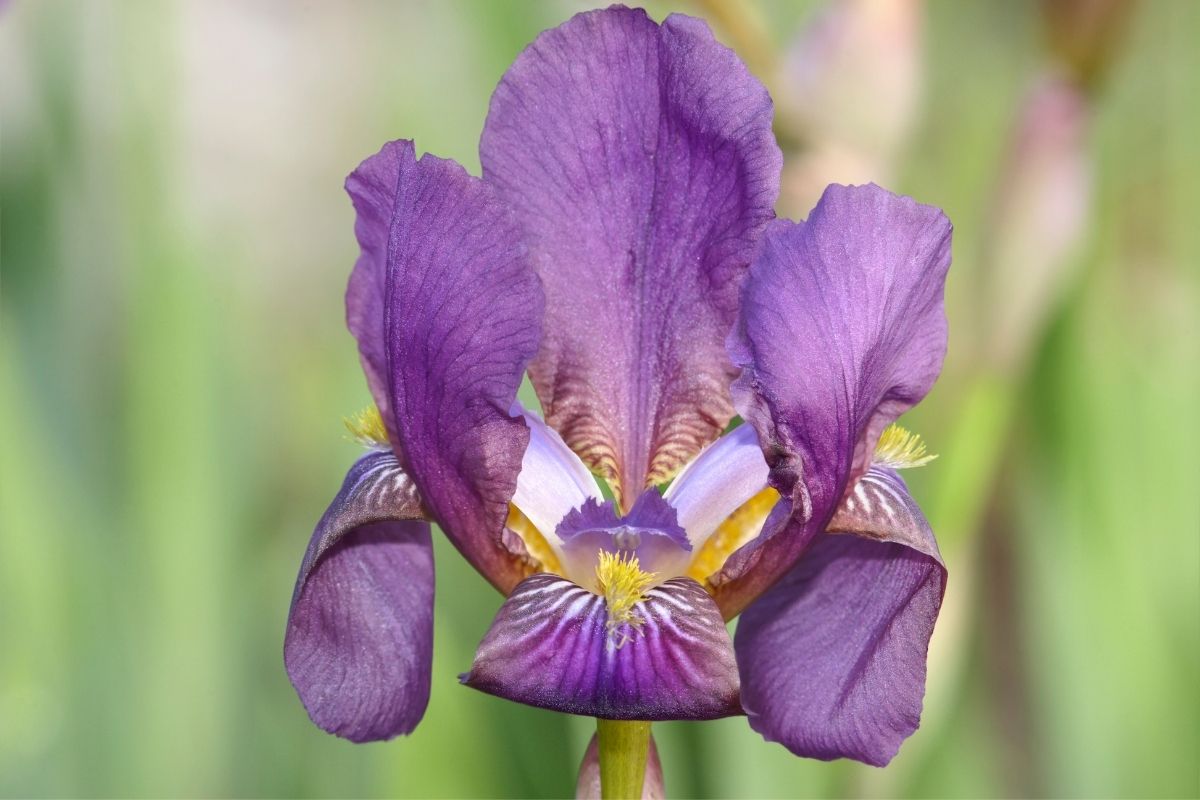
Bearded Irises are probably one of the most recognizable of all the iris plants. It is a sub-variety of the German Iris and is known for its uniquely shaped petals.
These petals are wide, circular and droop out and down quite dramatically. The key feature of these petals though is the crimp along the outer petal, creating a crenelation type pattern that is truly beautiful.
The apparent beard of this Iris is actually a fuzzy stem that sticks out from the center of the Iris. The closer to this stem you go, the less color the Iris will retain within the petals, appearing white in the center.
However, the further to the edge of the petals you go, the more color appears. These colors tend to be pastels of deep purple, pink, blue, and white, which are gorgeous in the summer months.
There are three types of Bearded Iris: the Tall Bearded Iris, which stands higher than 28 inches, the Intermediate Bearded Iris, which is between 16 and 27 inches tall, and the Dwarf Bearded Iris, which stands at between 8 and 15 inches tall.
There is not much difference between the varieties, but the Dwarves tend to hold color in their petals better and tend to tolerate shade better than their cousins.
2. Dutch Iris
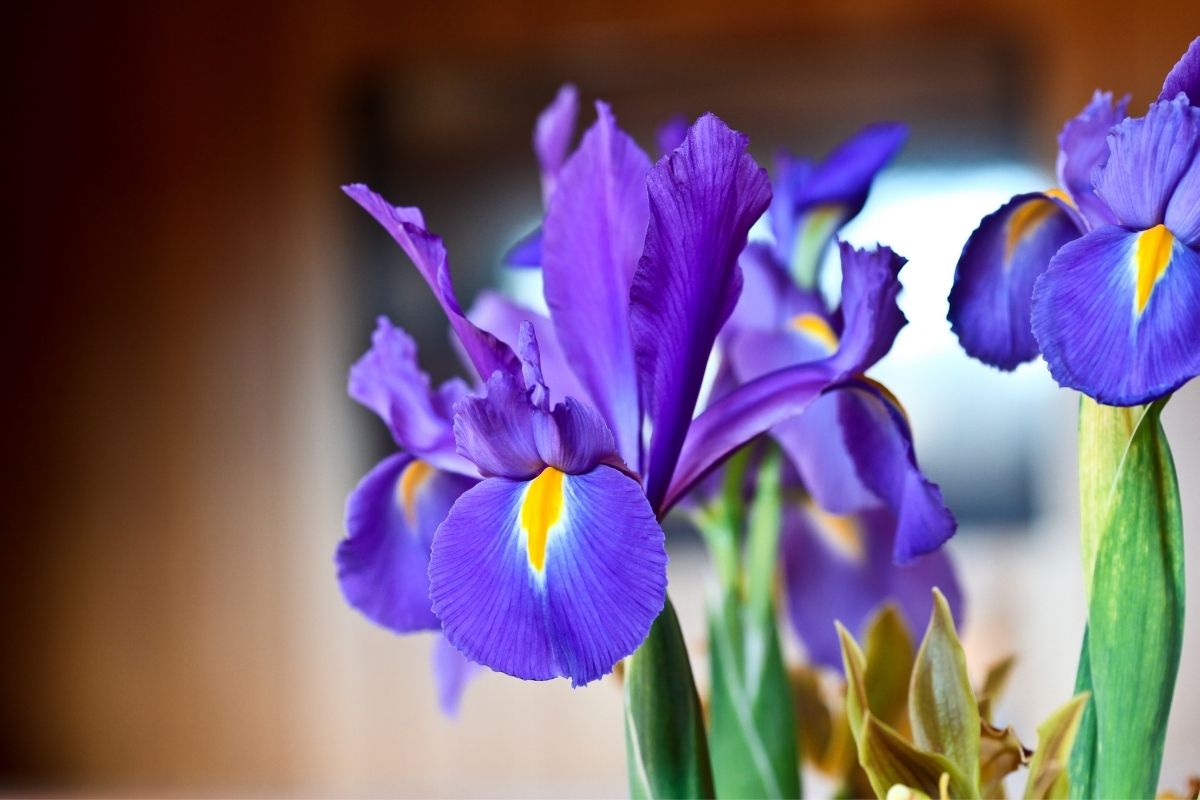
The Netherlands are known for having vast fields of colorful flowers, with tulips being the one that most people think of, but they also have their very own kind of Iris.
These flowers have three upright petals that remain rigid and sky facing, while also having three drooping petals that hang down below the center of the flower.
These are probably the easiest Irises to plant and will be the most reliable in surviving throughout the year.
This coupled with the fact that they come in an almost endless variety of colors means that gardeners love to have them in their garden as either full display plants or as an easy plant to fill a gap that they may have in a flowerbed.
They grow to between 20 and 24 inches tall and will need full sunlight to grow properly, but apart from that they are easy plants to have.
3. Dwarf Iris
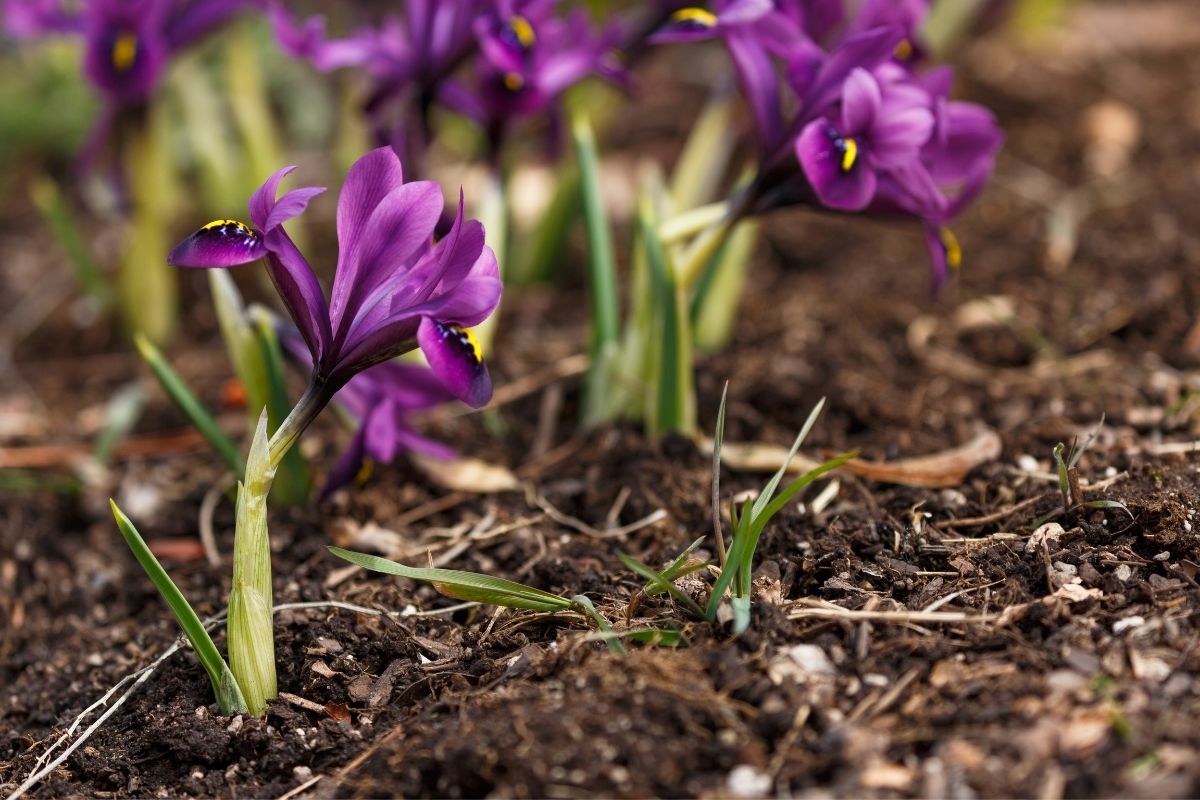
The Dwarf Iris is its own species of Iris separate from dwarf varieties of Iris, like the Bearded Dwarf Iris.
These flowers bloom with three rigid, skyward facing petals and three petals that spread outwards but do not droop, instead surrounding the bloom itself.
The colors of the Dwarf Iris are mostly a rich blue or purple, with streaks of color in the center of the petal.
Most commonly, these streaks of color are a solid yellow, which – when planted in abundance – creates a vivid and wonderful landscape that is unmatched by almost anything in nature.
As expected, Dwarf Irises are not tall. They reach a maximum of 8 inches in height, but are commonly between 4 and 6 inches.
This makes them fantastic indoor plants to liven up a house, or great ornate plants that you can place in the perfect position around your pond or a rock garden.
4. Japanese Iris
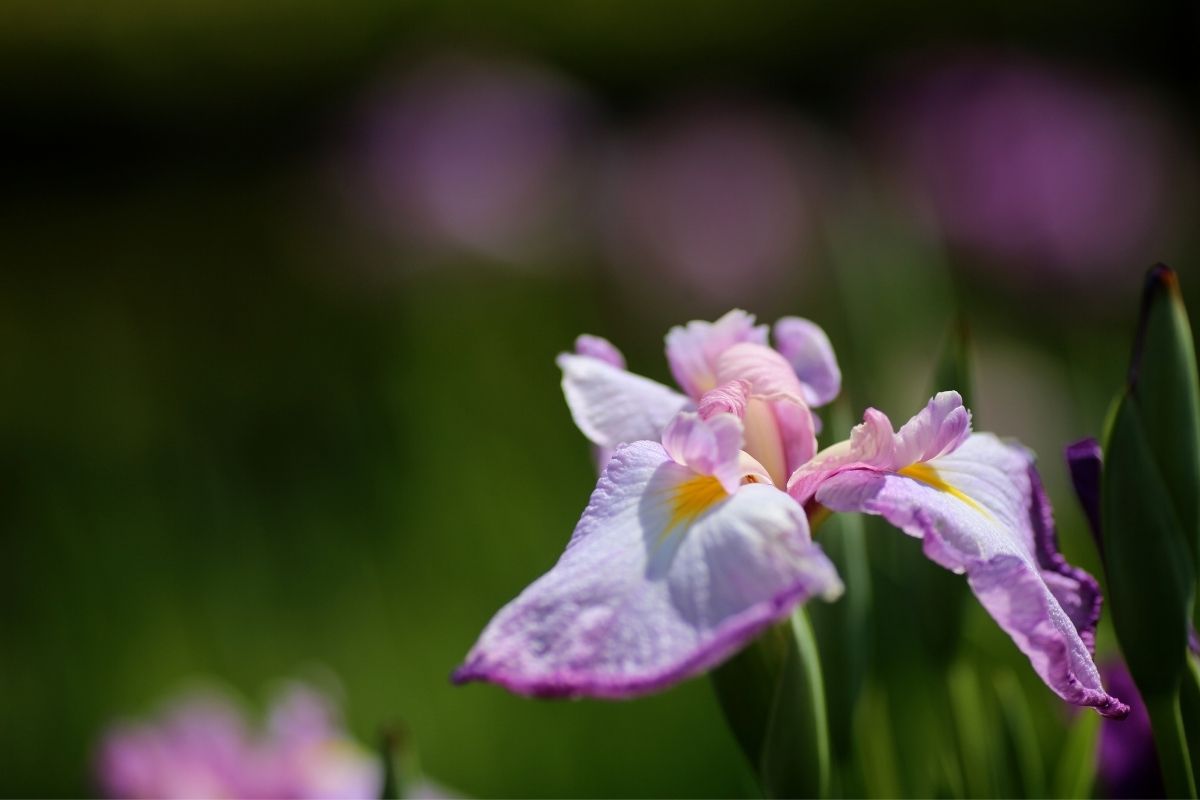
The Japanese Iris is one that has flown under the radar for many years. It is not as sought after as the German or Bearded Irises, nor is it as grown in abundance as the Dutch Irises.
Yet, this should not distract you from planting these plants or using them in your garden.
They are incredibly unique and have a distinct and graceful beauty to them that makes them perfect for a crafted water garden or any other garden that is designed for tranquility and relaxation.
The most striking thing about these Irises is the size of their petals. Their petals are enormous and can grow to be bigger than most hands and while they droop it is only the tiniest amount, making it seem elegant but deliberate.
The six petals this plant produces overlap one another while maintaining a flattened appearance, which in turn exposes the center of the bloom. This center has no beard, but is often resplendent with a different color from the petal.
The coloring of the Japanese Iris is amazing, as – unlike other irises – the color does not get bolder the further towards the petals edge you go.
Instead, the color is light at the petals edge, and gets deeper and darker the closer to the center you get, before hitting a very rich color at the center that is different from the petals.
Japanese Irises can come in a veritable display of colors, but five colors are more popular than the rest. These are blue, white, red, pink, and purple.
While the petals are big, the plants themselves are also massive. They range from 24 inches at the shortest to a whooping 48 inches at the tallest, which makes them perfect for accentuating stone or wooden displays that might over-wise overshadow other plants.
5. Louisiana Iris
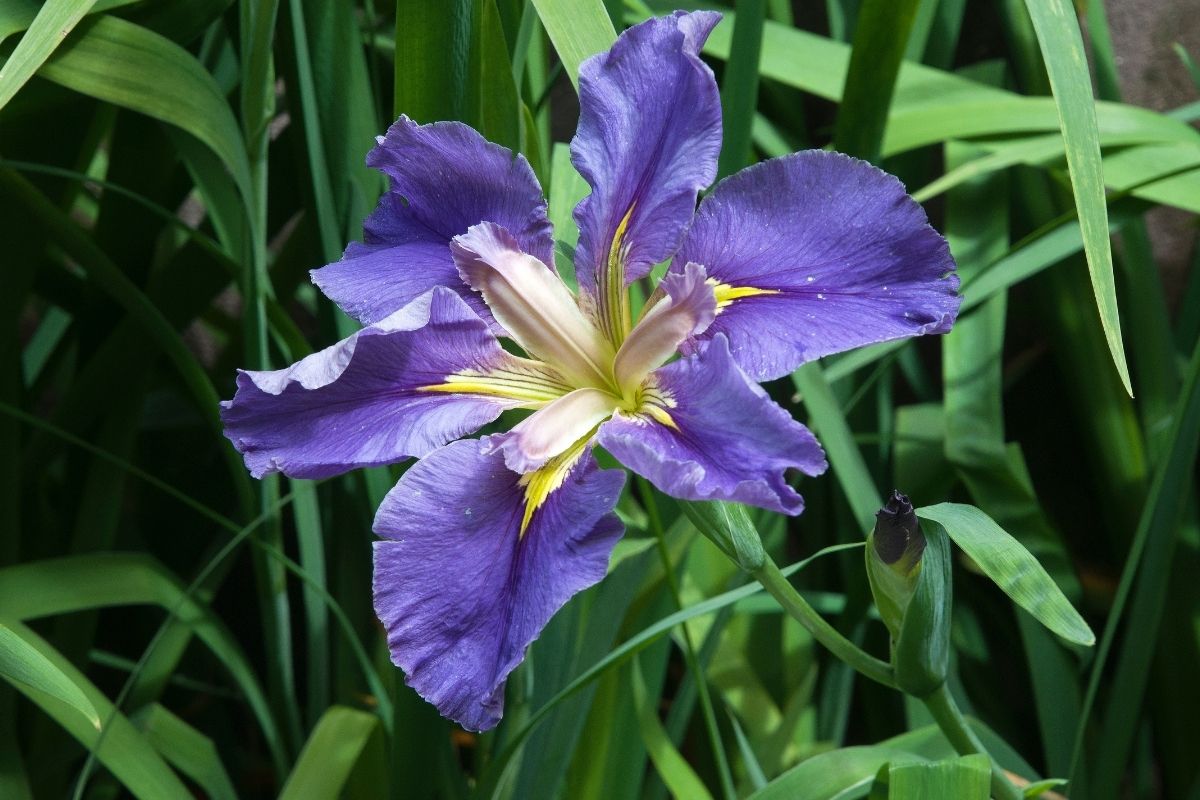
Next up is another beardless Iris, but from a completely different region and climate, the Louisiana Iris.
This iris is from the incredibly damp and hot region of Louisiana in the United States, making it unique amongst irises for its preferred growing region – normally irises prefer dry, arid places or cold, mountainous ones.
As before, these irises have three upright petals and three drooping ones, but the petal’s stem that connects them to the plant makes them look interesting.
It is thinner than other petals, which either blend into their stem well, or it is much thicker. This makes them look much more delicate and makes the petals look like they are just hanging in midair from the right angle.
The petals are also fan shaped with a much deeper central indent, rather than a flatter shape as we saw with the Japanese Iris.
The most common colors for this plant are red, purple, pink, and blue, but they can come in other colors.
The other thing to note about the colors is that the main color they are is normally the only color that appears on the bloom, but the color is normally so bold and beautiful it doesn’t matter.
These plants are also on the larger side, being between 30 and 36 inches tall, but to us, it just makes them appear all the more graceful, especially when the leaves dance in the rain.
6. Siberian Iris
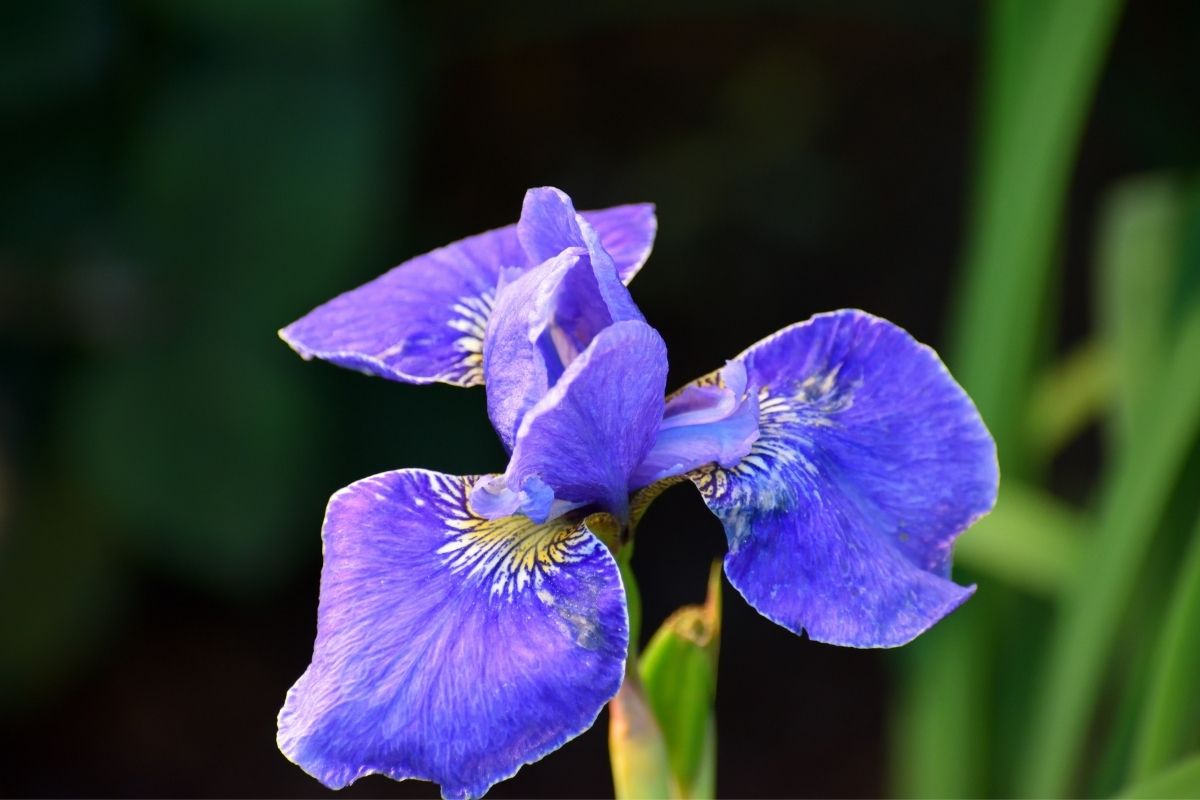
The Siberian Iris is native to Europe and Central Asia and, in converse to the Louisiana Iris, it is a plant that is happy in more temperate and colder climes.
This iris again has the standard three petals upward facing and three petals downward facing as most irises do, however the petals are slightly ruffled and though they are delicate, when they begin to die these petals remain somewhat beautiful until the end without becoming desiccated and ratty.
One of the most amazing things about Siberian Irises is that their petals can be bi-colored. What this means is that the three upright petals can be one color and the downward facing petals an entirely different color.
One of the most popular bi-color Siberian Irises is one with white upper petals and pink flower petals.
This is because the plant itself can be a hybrid that can have multiple sets of chromosomes, creating wonderfully vivid displays.
Like the other varieties, these plants are beardless and are actually surprisingly tough, being able to withstand a lot more punishment than their relatives before they are damaged.
This may be due to the ecosystems they live in natively. The Siberian Iris can have a variety of colors, but they tend to be blue, violet, purple, or some mixture of the three, due to their heritage.
Like those before them on this list, this plant can grow very tall. At its shortest, it is about 30 inches and at its tallest, it is about 36 inches tall.
One of the reasons for these plants being so tall – Japanese, Louisiana, and Siberian – is that they are also wild plants and have not been cultivated solely for a garden environment.
7. Crested Iris

The last iris for this list is the Crested Iris, a charming little plant endemic to the United States of America.
They exclusively live in the eastern half of our country, but considering that millions of square miles of land and these plants are not threatened at all, you shouldn’t worry about them.
They are perhaps one of the most delicate species and are the smallest to appear on this list. Their maximum height is only around 4 inches tall, and most are only around 3 inches tall.
This tiny nature is continued into the petals, which while wide and fan shaped at the end, are narrow until that point. Unlike other irises, these plants can have more than six petals and regularly do.
The other interesting thing about the petals is that there are normally 3 or 4 prominent ones with two different colors on them, one that follows the majority of the petal along the outer rim and the other that is right in the center.
The other petals all have the same color as the dominant color of the prominent petals. This makes the iris flower stand out amongst the forest floor despite its tiny size.
This iris could work really well in your garden as, if protected, they can live up to 10 years and will lie dormant in winter, so you don’t have to worry about it.
Conclusion
Irises are absolutely beautiful plants that make any garden look a thousand times better.
The only issue is making sure that they have the right conditions for the right plant, as they exist in very different environments all over the world.
Still, no matter what kind of garden you are trying to make, you could always add an iris somewhere in the mix. It will make your garden feel that much more elegant without taking anything away.







